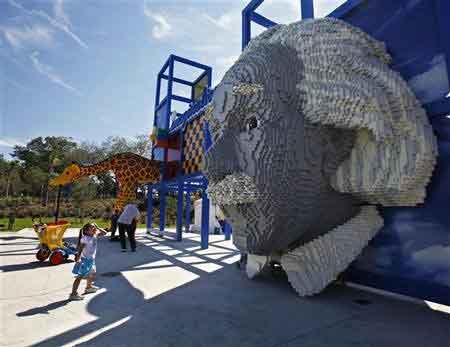歐洲核子研究中心去年9月在實(shí)驗(yàn)中發(fā)現(xiàn),中微子速度快過光速大約每秒6公里,駁倒愛因斯坦相對(duì)論中沒有物質(zhì)可以快過光速的理論。如今顯示這可能只是一起科學(xué)“烏龍事件”。歐洲核子研究中心去年的實(shí)驗(yàn)結(jié)果有誤,原因是一條連接全球定位接收器和計(jì)算機(jī)的光纖電纜出現(xiàn)了松動(dòng)。
歐洲核子研究中心發(fā)言人詹姆斯·吉利斯,承認(rèn)實(shí)驗(yàn)結(jié)果“現(xiàn)在出現(xiàn)疑問”。歐洲核子研究中心已鎖定去年實(shí)驗(yàn)中兩處各自獨(dú)立的問題。這兩處問題均與全球定位系統(tǒng)接收器相關(guān),可能導(dǎo)致錯(cuò)誤讀取中微子束抵達(dá)意大利實(shí)驗(yàn)室的準(zhǔn)確時(shí)間。事實(shí)上,即便是參與去年實(shí)驗(yàn)的科學(xué)家,也對(duì)實(shí)驗(yàn)結(jié)果持高度謹(jǐn)慎態(tài)度。畢竟,這一結(jié)論直接挑戰(zhàn)愛因斯坦相對(duì)論中“物體運(yùn)動(dòng)速度不能大于真空光速”的基本原則。歐洲核子研究中心準(zhǔn)備繼續(xù)發(fā)射中微子束,重做測試,以斷虛實(shí)。

|
 |
|
A girl looks at a large bust of Albert Einstein created out of lego bricks, displayed at Legoland Florida during its grand opening celebration in Winter Haven, Florida October 14, 2011. |
The world of science was upended last year when an experiment appeared to show one of Einstein's fundamental theories was wrong - but now the lab behind it says the result could have been caused by a loose cable.
Physicists at the CERN research institute near Geneva appeared to contradict Albert Einstein's 1905 Special Theory of Relativity last year when they reported that sub-atomic particles called neutrinos could travel fractions of a second faster than light.
Einstein's Special Theory of Relativity, which underpins the current view of how the universe works, says that nothing can travel faster than light, and doing so would be like travelling back in time.
James Gillies, a spokesman for European Organization for Nuclear Research, or CERN, said on Wednesday the lab's startling result was now in doubt.
Earlier on Wednesday, ScienceInsider, a website run by the American Association for the Advancement of Science, reported that the surprising result was down to a loose fibre optic cable linking a Global Positioning System satellite receiver to a computer.
Gillies confirmed that a flaw in the GPS system was now suspected as a possible cause for the surprising reading. Further testing was needed before any definite conclusions could be reached, he added.
The faster-than-light finding was recorded when 15,000 neutrino beams were pumped over three years from CERN to an underground Italian laboratory at Gran Sasso near Rome.
"A possible explanation has been found. But we won't know until we have tested it out with a new beam to Gran Sasso," Gillies told Reuters in Geneva.
Physicists on the experiment, called OPERA, said when they reported it last September that they had checked and rechecked over many months anything that could have produced a misreading before announcing what they had found.
A second test whose results were announced in November appeared to provide further evidence that neutrinos were travelling faster than light. But many experts remained sceptical of a result that would have overturned one of the fundamental principles of modern physics.
Edward Blucher, chairman of the Department of Physics at the University of Chicago, said the original finding would have been breathtaking if it had been true. As it was, the research inspired many spirited discussions, if few believers.
"I don't think I met anyone who said I bet it's going to be true. I think the people on the experiment worked as carefully as they could and I think they ran out of ideas of what could be wrong and they decided to present it," he said.
"Maybe they should have waited a few more months," he added.
Gillies said CERN would be issuing a full statement early on Thursday.
相關(guān)閱讀
(Agencies)

(英語點(diǎn)津?Rosy 編輯)
